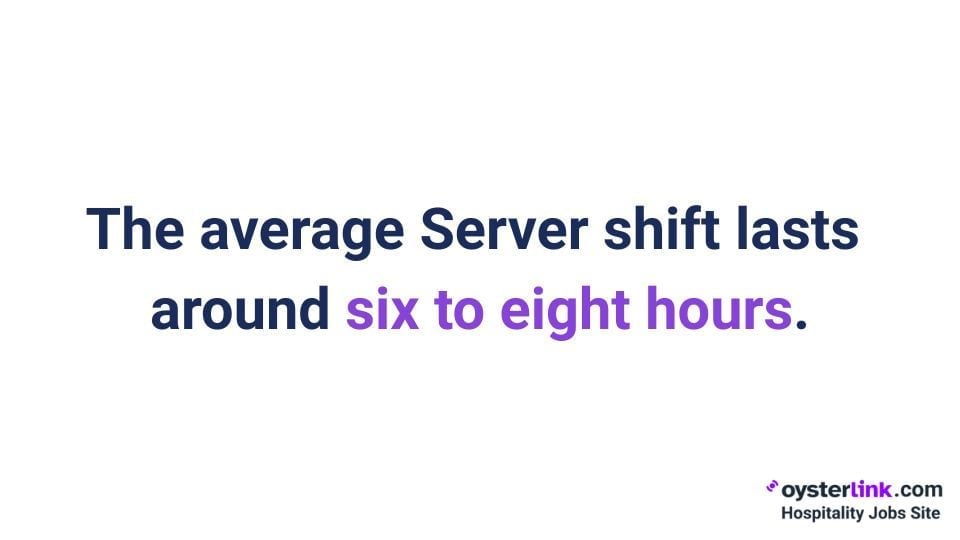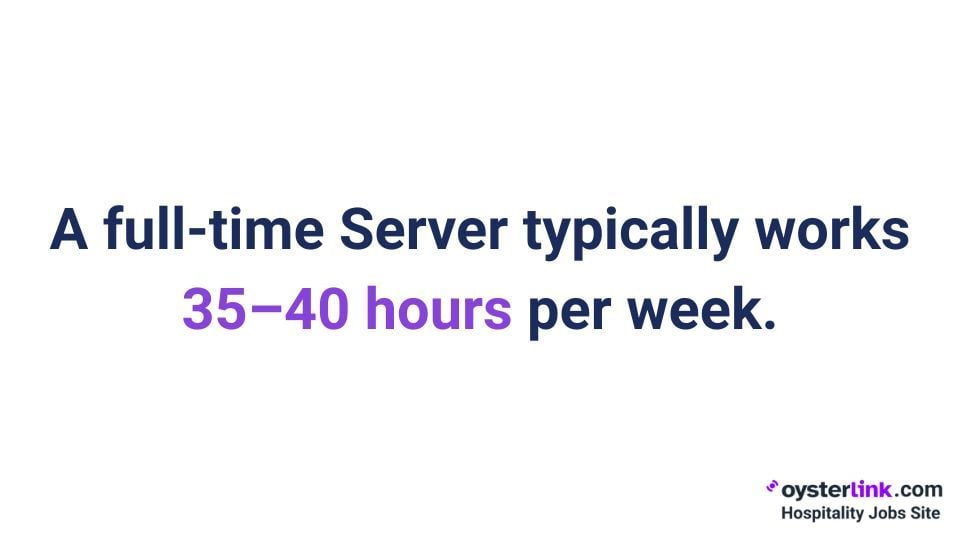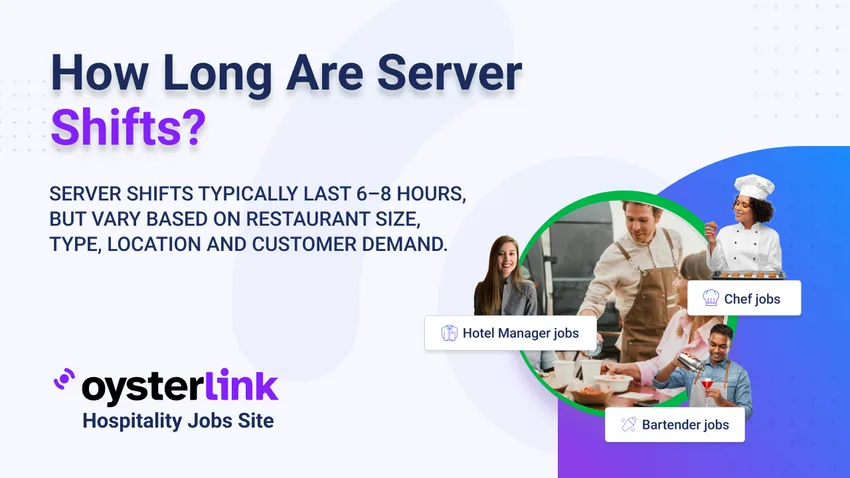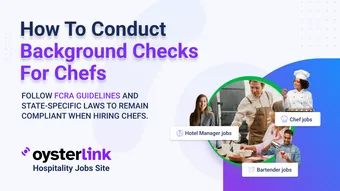Thinking about applying for your first Server job? One of the key things you'll want to know is how long are Server shifts.
In this guide, we'll break down what to expect from your Server shifts, including how they vary depending on whether you're working full-time, part-time or seasonally.
We’ll also take a closer look at federal laws regarding shift hours, breaks and overtime pay, along with state-specific regulations you should know.
How Long Are Server Shifts?
In general, the average Server shift lasts around six to eight hours. However, depending on the type of restaurant, shifts can be shorter or longer.

That said, shift duration depends on the following factors:
- Restaurant’s size: Larger restaurants with more tables and customers may require longer shifts, while smaller venues might have shorter, more flexible schedules.
- Restaurant type: Fast-casual spots often have shorter shifts (4–6 hours), while fine dining establishments may require longer shifts (8+ hours) to accommodate multi-course meals and extended service times.
- Location: Restaurants in high-traffic areas, such as city centers or tourist destinations, may have longer shifts due to steady customer flow, while those in quieter areas may have shorter, more predictable shifts.
- Specific duties of the Server: Servers who handle additional responsibilities, such as bartending, setting up private events, or assisting with takeout orders, may work longer or split shifts.
- Customer demand: The number of guests dining at a given time impacts shift length. Peak hours, weekends and holidays often lead to extended shifts, while slower periods may result in shorter ones.
Full-Time vs. Part-Time Server Shifts
When it comes to working as a Server, it’s important to distinguish between full-time and part-time positions.
The hours worked in each type of role will vary, and understanding the difference can help you find a job that fits your personal schedule.
Full-time Server shifts
A full-time Server typically works 35–40 hours per week. In this case, you can expect to work five shifts per week, each averaging seven to eight hours.
Full-time servers usually have a more consistent schedule, but they also take on more responsibility.
The shifts might be longer because full-time Servers often take on more tables or larger sections during busy times.

Part-time Server shifts
Part-time Servers usually work fewer than 35 hours per week. If you prefer a more flexible schedule or can't commit to full-time hours, a part-time position might be a good fit.
Part-time shifts may range anywhere from four to six hours depending on the restaurant's needs.
The best part? You may have the option to pick up shifts as your availability allows, giving you more control over your work schedule.
Seasonal Server Shifts
As a seasonal Server, your shift length can vary depending on the time of year, especially during busy seasons like the holidays or summer.
During the busy holiday season or summer months, many restaurants experience a surge in customers. For seasonal Servers, this can mean longer hours and more shifts.
Some restaurants may offer seasonal positions that require Servers to work four to six shifts a week, each ranging from five to eight hours.
These shifts can often extend well into the evening, especially during dinner rushes or special events.
While seasonal work is often temporary, it provides an opportunity to gain experience in the restaurant industry, with the added benefit of earning tips during high-demand periods.
See also: How To Become a Server
What Does the Law Say About Server Shifts and Breaks?
In addition to understanding typical shift lengths, it’s important to know the federal regulations that govern shifts.
These laws ensure that your rights are protected when it comes to overtime pay, meal breaks and working hours.
Fair Labor Standards Act (FLSA)
Under the FLSA, Servers are typically classified as hourly employees. The FLSA establishes rules regarding the minimum wage, overtime pay and other work conditions.
Generally, Servers must be paid at least the federal minimum wage unless they earn enough in tips to bring their total pay above the minimum.
Overtime Law
Servers are entitled to overtime pay when they work more than 40 hours a week.
This means that for any hours worked beyond 40, Servers must be paid at 1.5 times their regular hourly rate.
Keep in mind that the overtime law applies only to non-exempt workers, and Servers are generally considered non-exempt under the FLSA.
Meal and rest breaks
The FLSA does not require employers to provide meal or rest breaks, but if breaks are given, they must meet specific criteria:
- Meal breaks: Many restaurants offer servers a 30-minute meal break when working shifts over five hours. This break is usually unpaid, but the time is not counted toward the total work hours.
- Rest breaks: If a shift is long enough, some employers may offer a 10–15 minute rest break, but this is not required by federal law.
State-Specific Shift and Break Regulations
While federal law sets a baseline for Server work conditions, individual states can have their own rules regarding breaks and shift lengths.
Below is a breakdown of how different states handle server shifts and breaks.
State | Meal Break Requirement | Rest Break Requirement | Overtime Pay Law |
California | 30-minute break after five hours | 10-minute rest break every four hours | Overtime after eight hours in a day |
New York | 30-minute break for shifts > six hours | No mandated rest break | Overtime after 40 hours/week |
Texas | No required meal break | No required rest break | Overtime after 40 hours/week |
Florida | No required meal break | No required rest break | Overtime after 40 hours/week |
Illinois | 20-minute break after five hours | No required rest break | Overtime after 40 hours/week |
As you can see, states like California and New York have stronger labor laws, offering more protection for Servers in terms of break time and overtime pay.
On the other hand, states like Texas and Florida have fewer regulations on breaks, making the working conditions more dependent on the individual restaurant.
Strategies for Managing Variable and Long Shifts
Server shift hours can vary, but there are ways to ensure you're ready for both short and long ones.
Managing long Shifts
Long shifts can be exhausting, but these tips can help you stay energized:
- Eat light meals throughout the day to avoid sluggishness.
- Stay hydrated to maintain your energy levels.
- Take advantage of breaks when available to rest and reset.
- Wear comfortable shoes to reduce foot and leg pain, especially during busy shifts.
Dealing with shift variability
If you're working part-time or seasonally, your shifts might change frequently. Here’s how to handle the unpredictability:
- Communicate with your manager about your availability to get a more stable schedule.
- Keep a flexible mindset since last-minute shift changes are common.
- Maintain a good attitude to adapt more easily to different shift lengths.
Kickstart Your Server Career with OysterLink’s Resources
So, how long are Server shifts? It really depends on whether you’re working full-time, part-time or seasonally, as well as the type of restaurant you’re in.
There’s no one-size-fits-all answer, but knowing what to expect and how to manage your shifts can help you make an informed decision.
It’s also crucial to understand both federal and state regulations regarding working hours, breaks and overtime pay so that you’re protected as you start your career.
If you're ready to take the leap into your first Server job, OysterLink can help you find the right restaurant that fits your schedule.
Visit OysterLink for job listings, salary insights and career tips to start your journey as a Server today!










Loading comments...